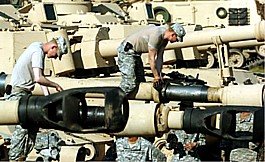Guard unit makes do
 A compressed training schedule has given soldiers less time to learn their weapons systems.
A compressed training schedule has given soldiers less time to learn their weapons systems.FORT STEWART, Ga. — The pressures that the conflict in Iraq is putting on the Army are apparent amid the towering pine trees of southeast Georgia, where the Third Infantry Division is preparing for the likelihood that it will go back to Iraq for a third tour.
Members of the Third Infantry Division have been conducting training exercises in preparation for a third deployment to Iraq. But equipment for the training is short, and the time for it has been reduced.
Col. Tom James, who commands the division’s Second Brigade, acknowledged that his unit’s equipment levels had fallen so low that it now had no tanks or other armored vehicles to use in training and that his soldiers were rated as largely untrained in attack and defense.
The rest of the division, which helped lead the invasion of Iraq in 2003 and conducted the first probes into Baghdad, is moving back to full strength after many months of being a shell of its former self.
But at a time when Pentagon officials are saying the Army is stretched so thin that it may be forced to go back on its pledge to limit National Guard deployment overseas, the division’s situation is symptomatic of how the shortages are playing out on the ground.
The enormous strains on equipment and personnel, because of longer-than-expected deployments, have left active Army units with little combat power in reserve. The Second Brigade, for example, has only half of the roughly 3,500 soldiers it is supposed to have. The unit trains on computer simulators, meant to recreate the experience of firing a tank’s main gun or driving in a convoy under attack.
“It’s a good tool before you get the equipment you need,” Colonel James said. But a few years ago, he said, having a combat brigade in a mechanized infantry division at such a low state of readiness would have been “unheard of.”
Other than the 17 brigades in Iraq and Afghanistan, only two or three combat brigades in the entire Army — perhaps 7,000 to 10,000 troops — are fully trained and sufficiently equipped to respond quickly to crises, said a senior Army general.
Most other units of the active-duty Army, which is growing to 42 brigades, are resting or being refitted at their home bases. But even that cycle, which is supposed to take two years, is being compressed to a year or less because of the need to prepare units quickly to return to Iraq.
Read the rest at the NY Times
Related Link:

<< Home